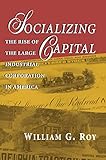Socializing Capital : The Rise of the Large Industrial Corporation in America / William G. Roy.
Material type: TextPublisher: Princeton, NJ : Princeton University Press, [1999]Copyright date: ©1997Edition: Course BookDescription: 1 online resource (360 p.) : 8 line illus. 10 tablesContent type:
TextPublisher: Princeton, NJ : Princeton University Press, [1999]Copyright date: ©1997Edition: Course BookDescription: 1 online resource (360 p.) : 8 line illus. 10 tablesContent type: - 9780691010342
- 9781400822270
- 338.6/44/0973 20
- HD2785 .R598 1997eb
- online - DeGruyter
- Issued also in print.
| Item type | Current library | Call number | URL | Status | Notes | Barcode | |
|---|---|---|---|---|---|---|---|
 eBook
eBook
|
Biblioteca "Angelicum" Pont. Univ. S.Tommaso d'Aquino Nuvola online | online - DeGruyter (Browse shelf(Opens below)) | Online access | Not for loan (Accesso limitato) | Accesso per gli utenti autorizzati / Access for authorized users | (dgr)9781400822270 |
Browsing Biblioteca "Angelicum" Pont. Univ. S.Tommaso d'Aquino shelves, Shelving location: Nuvola online Close shelf browser (Hides shelf browser)

|

|

|

|

|

|

|
||
| online - DeGruyter Rethinking "Gnosticism" : An Argument for Dismantling a Dubious Category / | online - DeGruyter Paths of Fire : An Anthropologist's Inquiry into Western Technology / | online - DeGruyter Dissolution : The Crisis of Communism and the End of East Germany / | online - DeGruyter Socializing Capital : The Rise of the Large Industrial Corporation in America / | online - DeGruyter Gatekeepers of Growth : The International Political Economy of Central Banking in Developing Countries / | online - DeGruyter Considered Judgment / | online - DeGruyter The Complexity of Cooperation : Agent-Based Models of Competition and Collaboration / |
Frontmatter -- Contents -- Figures -- Tables -- Preface -- CHAPTER ONE. Introduction -- CHAPTER TWO. A Quantitative Test of Efficiency Theory -- CHAPTER THREE. The Corporation as Public and Private Enterprise -- CHAPTER FOUR. Railroads: The Corporation's Institutional Wellspring -- CHAPTER FIVE. Auxiliary Institutions: The Stock Market, Investment Banking, and Brokers -- CHAPTER SIX. Statutory Corporate Law, 1880-1913 -- CHAPTER SEVEN. Prelude to a Revolution -- CHAPTER EIGHT. American Industry Incorporates -- CHAPTER NINE. Conclusion: A Political Sociology of the Large Corporation -- Notes -- References -- Index
restricted access online access with authorization star
http://purl.org/coar/access_right/c_16ec
Ever since Adolph Berle and Gardiner Means wrote their classic 1932 analysis of the American corporation, The Modern Corporation and Private Property, social scientists have been intrigued and challenged by the evolution of this crucial part of American social and economic life. Here William Roy conducts a historical inquiry into the rise of the large publicly traded American corporation. Departing from the received wisdom, which sees the big, vertically integrated corporation as the result of technological development and market growth that required greater efficiency in larger scale firms, Roy focuses on political, social, and institutional processes governed by the dynamics of power. The author shows how the corporation started as a quasi-public device used by governments to create and administer public services like turnpikes and canals and then how it germinated within a system of stock markets, brokerage houses, and investment banks into a mechanism for the organization of railroads. Finally, and most particularly, he analyzes its flowering into the realm of manufacturing, when at the turn of this century, many of the same giants that still dominate the American economic landscape were created. Thus, the corporation altered manufacturing entities so that they were each owned by many people instead of by single individuals as had previously been the case.
Issued also in print.
Mode of access: Internet via World Wide Web.
In English.
Description based on online resource; title from PDF title page (publisher's Web site, viewed 30. Aug 2021)


